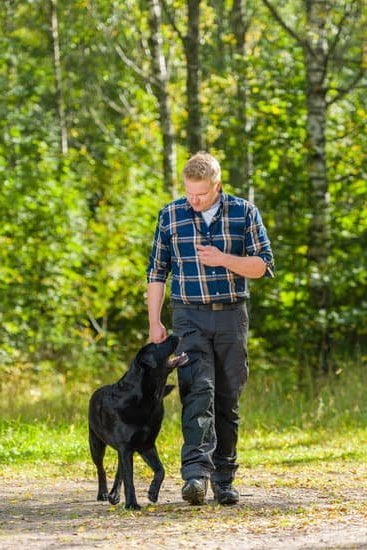Are you tired of your furry friend waking you up before the crack of dawn? If so, you may be wondering how to train a dog to sleep later.
Both dogs and their owners can benefit from a good night’s sleep, which is why it’s essential to establish healthy sleep habits for your canine companion. In this article, we will explore various strategies and techniques to help your dog stay in bed longer in the morning, allowing for a more peaceful start to your day.
Understanding your dog’s sleep needs is crucial in addressing early wake-up calls. Just like humans, dogs have specific sleep patterns and requirements that can be influenced by various factors. By delving into these elements, we can identify what may be affecting your dog’s ability to sleep later and work towards implementing effective solutions.
Creating a bedtime routine for your dog is key in promoting relaxation and preparing them for a later bedtime. Consistent and calming activities can help signal to your dog that it’s time to wind down and get ready for a restful night’s sleep. Additionally, engaging in physical activity and mental stimulation throughout the day can also play a significant role in helping your dog stay asleep longer in the morning.
Stay tuned as we delve deeper into the importance of quality sleep for dogs and their owners, as well as exploring practical tips on how to establish healthy sleeping habits for your canine companion. With patience, consistency, and the right approach, you can successfully train your dog to sleep later while ensuring both you and your pet enjoy a restful night’s sleep.
Understanding Your Dog’s Sleep Needs
Dogs, like humans, require a good night’s sleep to stay healthy and happy. Understanding your dog’s sleep patterns is crucial in training them to sleep later. The typical sleep cycle of a dog consists of several short naps throughout the day and longer periods of deep sleep at night. Factors such as age, breed, size, and activity level can influence how much sleep a dog needs and when they prefer to sleep.
To help your dog sleep later in the morning, it is important to consider what may be affecting their ability to do so. Some potential factors that may be contributing to early wake-ups include discomfort or pain, anxiety or stress, lack of physical activity or mental stimulation, or an inconsistent bedtime routine. Identifying these factors can help you address them and create an environment conducive for your dog’s late sleeping habits.
To ensure that your dog gets the proper amount of rest, it is essential to establish a consistent bedtime routine. This routine should include calming activities such as a walk before bed, feeding them at the same time each night, and providing a comfortable sleeping environment. Additionally, mental stimulation during the day through interactive playtime and training exercises can help tire them out and encourage a deeper rest at night.
Establishing a Bedtime Routine
Establishing a consistent and calming bedtime routine for your dog is crucial in training them to sleep later in the morning. Just like humans, dogs thrive on routine, and having a structured nighttime ritual can help signal to your pet that it’s time to wind down and prepare for sleep. Here are some tips on creating an effective bedtime routine for your furry companion:
Consistency Is Key
Consistency is crucial when establishing a bedtime routine for your dog. Try to stick to the same schedule every night, as this will help regulate your dog’s internal body clock and promote better sleep habits. Whether it’s going for a short walk, giving them a relaxing massage, or engaging in quiet playtime, make sure to follow the same sequence of activities each night before bedtime.
Limit Stimulating Activities Before Bed
Avoid engaging in high-energy activities with your dog right before bedtime. Instead, opt for quiet and calming interactions that can help them relax. This could include gentle petting, soft spoken words of encouragement, or even practicing some basic obedience commands to ease their mind and prepare them for sleep.
Create a Relaxing Environment
Setting up a tranquil and relaxing environment can also aid in preparing your dog for a peaceful night’s sleep. Dim the lights in your home, play soothing music or white noise, and provide them with a comfortable sleeping area that they can associate with restfulness. By creating a serene atmosphere, you can help your dog unwind and transition into sleep mode more easily.
By implementing these tips and being patient with the process, you can effectively establish a bedtime routine that encourages your dog to sleep later in the morning. Remember that it may take time for your pet to adjust to the new routine, but with persistence and consistency, you’ll likely see positive results over time.
Exercise and Mental Stimulation
Benefits of Exercise for Dogs
Regular exercise is essential for a dog’s physical and mental well-being. Not only does it help them stay fit and healthy, but it also plays a crucial role in their overall behavior and quality of sleep. Dogs need an outlet for their energy, and without regular exercise, they may become restless and have difficulty settling down for sleep.
Mental Stimulation Through Play and Training
In addition to physical activity, mental stimulation is equally important for a dog’s overall health and sleep patterns. Engaging your dog in activities that challenge their mind, such as interactive toys, puzzles, or obedience training, can help tire them out both mentally and physically. This mental stimulation can contribute to better relaxation and longer sleep duration, ultimately leading to the ability to sleep later in the morning.
Timeframe for Exercise and Mental Stimulation
When planning your dog’s exercise routine and mental stimulation activities, it’s important to consider the timing in relation to bedtime. Providing physical activity too close to bedtime may have an energizing effect on your dog, making it more difficult for them to wind down and fall asleep.
Similarly, engaging in mentally stimulating activities right before bed may lead to heightened alertness rather than relaxation. Therefore, it’s best to incorporate these activities earlier in the day so that your dog has sufficient time to wind down before bedtime.
Creating a Comfortable Sleep Environment
When it comes to training a dog to sleep later, creating a comfortable sleep environment is essential. Just like humans, dogs need a cozy and tranquil space to rest in order to achieve quality sleep.
To ensure that your dog is able to sleep later in the morning, it’s important to provide them with an optimal sleeping environment. This includes using cozy bedding that is suitable for their size and breed, as well as eliminating any potential sleep disruptions in their sleeping area.
One way to create a comfortable sleep environment for your dog is by providing them with a comfortable and supportive bed. Dogs come in all shapes and sizes, so it’s important to choose a bed that fits their specific needs.
For example, larger breeds may benefit from orthopedic beds that provide extra support for their joints, while smaller breeds may prefer softer and more cushioned bedding. Additionally, it’s important to regularly clean your dog’s bedding and remove any odors or allergens that could disrupt their sleep.
In addition to using cozy bedding, it’s crucial to eliminate potential sleep disruptions in your dog’s sleeping area. This includes minimizing noise and light levels during the night, as well as ensuring that the temperature of the room is suitable for your dog’s comfort. By creating a calm and peaceful sleeping environment for your dog, you can help them relax and wind down more effectively, ultimately aiding in their ability to sleep later in the morning.
Addressing Potential Sleep Disturbances
Dogs, like humans, are prone to experiencing sleep disturbances that can cause them to wake up early. These sleep disturbances can stem from various factors such as discomfort, anxiety, or external stimuli. One common disturbance is discomfort caused by health issues or an uncomfortable sleeping environment. It’s essential to address any physical discomfort your dog may be experiencing by providing a comfortable bed with appropriate bedding and ensuring that the sleeping area is free from potential disruptions.
Another factor that may lead to early waking in dogs is anxiety or stress. Dogs can experience separation anxiety, fear of loud noises, or general unease that disrupts their sleep patterns. To manage and prevent these disturbances, consider creating a calming environment for your dog by using soft music or white noise machines to mask any disturbing sounds. Additionally, using aromatherapy with scents like lavender can help soothe your dog and promote relaxation.
External factors like light and temperature changes can also play a significant role in causing sleep disturbances for dogs. Ensuring that your dog’s sleeping area is conducive to darkness and has a comfortable temperature can help them stay asleep longer. Using blackout curtains and regulating the room temperature with fans or heaters if necessary can aid in avoiding early waking due to these factors.
By addressing these common sleep disturbances through environmental adjustments and providing comfort for your dog, you can effectively manage and prevent early waking, ultimately encouraging them to sleep later into the morning.
| Sleep Disturbance Factor | Solution |
|---|---|
| Discomfort | Provide comfortable bedding and eliminate potential disruptions in the sleeping area. |
| Anxiety | Create a calming environment with gentle sounds and aromatherapy. |
| External Factors (light/temperature changes) | Regulate the sleeping area for darkness and optimal temperature using blackout curtains and fans/heaters. |
Positive Reinforcement and Training Techniques
It’s important to use positive reinforcement techniques and training methods when trying to encourage your dog to sleep later and wake up at a more suitable time. Positive reinforcement involves rewarding your dog for exhibiting the desired behavior, which in this case is sleeping later. This can be done through treats, praise, or other forms of positive attention when your dog successfully stays in bed longer.
One common technique used for training a dog to sleep later is gradually adjusting their wake-up time. This can be done by setting an alarm 5-10 minutes later every day until you reach the desired wake-up time for your pet. Pair this with positive reinforcement by giving your dog a treat or praise when they stay in bed until the new, slightly later wake-up time.
Another effective method is to make waking up early less appealing for your dog. For example, if your dog’s primary motivation for waking up early is to go outside, try taking them out right before bedtime so they are less inclined to wake up at the crack of dawn. Alternatively, provide mental stimulation and toys that can keep them occupied in the morning without needing immediate attention from you.
Consistency is key when implementing these training techniques. It’s important to stick to the same routine and not give in to any attempts from your dog to wake you up earlier than desired. With patience and consistent reinforcement of the new habits, your furry friend will eventually adapt and learn to sleep later.
| Positive Reinforcement Techniques | Training Methods |
|---|---|
| Rewarding with treats | Gradually adjusting wake-up time |
| Praising for staying in bed | Making early wake-up less appealing |
| Providing attention when displaying correct behavior | Consistent routine adherence |
Patience and Consistency
In conclusion, training a dog to sleep later requires patience and consistency from the owner. It is important to understand that changing a dog’s sleep habits will not happen overnight and may require some time and effort. By establishing a consistent bedtime routine, providing ample exercise and mental stimulation, creating a comfortable sleep environment, and addressing potential disturbances, owners can work towards helping their dog sleep later in the morning.
Positive reinforcement techniques and training methods can also be effective tools in encouraging your dog to adjust their waking time. By rewarding desired behaviors and consistently reinforcing the desired wake-up time, owners can help their dogs understand the new sleep schedule. It is crucial for owners to be patient during this process, as it may take some time for the dog to fully adapt to the changes.
Lastly, it is important for owners to have realistic expectations about the process of training a dog to sleep later. While it may be challenging at times, with patience and consistency, many dogs can successfully adjust their sleep patterns.
It is essential for owners to stay committed to the process and remain consistent with their efforts in order to achieve long-term success in training their dogs to sleep later. Ultimately, by investing time and effort into this process, both dogs and their owners can benefit from improved sleep patterns and quality rest.
Frequently Asked Questions
How Do I Get My Dog to Stop Waking Up So Early?
To get your dog to stop waking up so early, it’s important to establish a consistent routine. Make sure your dog gets enough exercise during the day and feed them at the same time every night.
Avoid giving them late-night snacks or engaging in energetic play before bedtime. Additionally, try not to give them attention or let them outside first thing in the morning when they wake up too early, as this can reinforce the behavior.
How Do I Get My Dog to Sleep Later?
If you want your dog to sleep later, focus on creating a comfortable sleeping environment that encourages longer periods of rest. Make sure their sleeping area is cozy and quiet, and consider using blackout curtains if light is a contributing factor to their early waking.
Ultimately, it’s about providing a conducive atmosphere for extended sleep and being patient as your dog adjusts to a new schedule.
How Do I Train My Dog to Sleep at the End of the Bed?
To train your dog to sleep at the end of the bed, start by teaching basic commands like “down” or “bed.” Encourage them with praise or treats when they lie down at the designated spot at the end of your bed.
Use positive reinforcement consistently and be patient as your dog learns where they are supposed to sleep. It may take some time for them to understand, but with practice and consistency, they should eventually learn to sleep comfortably at the end of the bed.

Welcome to the blog! I am a professional dog trainer and have been working with dogs for many years. In this blog, I will be discussing various topics related to dog training, including tips, tricks, and advice. I hope you find this information helpful and informative. Thanks for reading!





